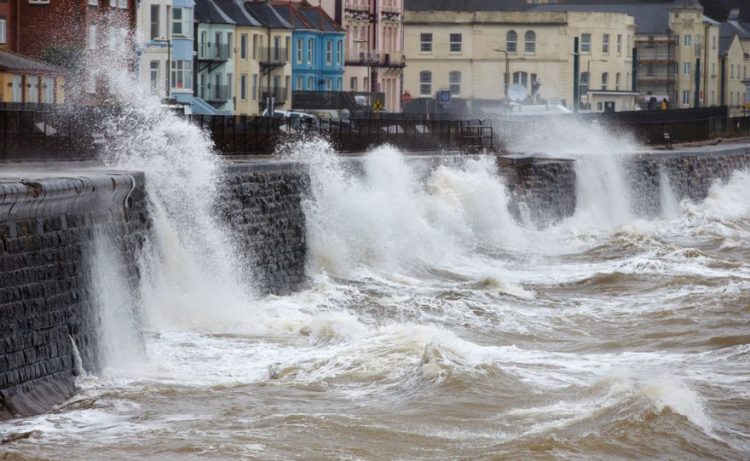When sea levels rise, damage costs rise even faster

Flood defense measures can counteract an increasing flood risk. Photo: Thinkstock
“When sea levels rise, damage costs rise even faster, our analyses show,” explains Markus Boettle, lead author of the study published in the journal Natural Hazards and the Earth System. Rising sea levels as a major impact of climate change pose a risk for coastal regions – the mean regional sea level rise takes effect by more frequent and more intense coastal flood events.
“At the same time, the severity of flood impacts is not only determined by environmental factors, but also to a significant extent by human decisions: flood defense measures can counteract the increasing flood risk,” says Boettle. “Our study illustrates that the complexity of climate change, adaptation, and flood damage can be disentangled by surprisingly simple mathematical functions to provide estimates of the average annual costs of sea-level rise over a longer time period.”
The scientists developed a method that translates the occurrence probability of flood events into the probability of inundation damage. Expected regional sea level rise is taken into account by separating two components, namely the increasing number of events and the increasing severity of each one. Moreover, potential flood defense measures like dikes or sea walls can be included into the calculations as they prevent or mitigate damages from storm surges.
+++Flood risks, damages, adaptation+++
Although coastal cities are different around the world and also flood-related threats have their own characteristics at different coasts, the scientists found general results. “Our equations basically work in Mumbai, New York, Hamburg – Pacific, Atlantic, or North Sea. In any location worldwide the same simple and universal expressions hold true,” says co-author Jürgen Kropp, deputy chair of PIK research domain Climate Impacts & Vulnerabilities. For an exemplary implementation of their method, the scientists applied it to the city of Copenhagen in Denmark: They found that a moderate mean sea level rise of 11 centimeters until mid-century would in the same period double economic losses in this city, given no action is taken.
“A concise assessment of potential economic consequences is indispensable for appraising the efficiency of adaptation measures,” explains co-author Diego Rybski. “Even when temperatures stabilize, sea levels will continue to rise and shape our coastlines for future generations. So, additional preventive measures need to be considered in addition to the mitigation of greenhouse gas emissions, to help coastal regions especially in transition and developing countries to adapt and to limit damage costs.”
+++A large share of the world population lives in coastal regions+++
Nevertheless, some constraints of the methodology remain, which was developed in the broader context of the European-funded RAMSES project. For instance, extreme events and attributed damages are not evenly distributed in time – there are years without any damage at all and others when quite unlikely floods may occur. The approach cannot forecast single events and associated damages, but estimates damage expectations over longer time-spans. Despite of the lack of knowledge regarding the timing of the extreme events, the statistical spreading of damage over years has been quantified by the researchers.
“A large share of the world population lives in coastal regions,” says Jürgen Kropp, director of the RAMSES project. “In the light of limited funds for adaptation it is an asset to provide comparable cost assessments. While mitigation remains of vital importance to keep climate impacts on a still manageable scale, an adaptation perspective can help to limit damage costs in the right places.”
Article: Boettle, M., Rybski, D., Kropp, J.P. (2016): Quantifying the effect of sea level rise and flood defence – a point process perspective on coastal flood damage. Natural Hazards and Earth System Sciences.
Weblink to the article once it is published: www.natural-hazards-and-earth-system-sciences.net/index.html
Weblink to RAMSES project: www.ramses-cities.eu
For further information please contact:
PIK press office
Phone: +49 331 288 25 07
E-Mail: press@pik-potsdam.de
Twitter: @PIK_Climate
Media Contact
All latest news from the category: Earth Sciences
Earth Sciences (also referred to as Geosciences), which deals with basic issues surrounding our planet, plays a vital role in the area of energy and raw materials supply.
Earth Sciences comprises subjects such as geology, geography, geological informatics, paleontology, mineralogy, petrography, crystallography, geophysics, geodesy, glaciology, cartography, photogrammetry, meteorology and seismology, early-warning systems, earthquake research and polar research.
Newest articles

Making diamonds at ambient pressure
Scientists develop novel liquid metal alloy system to synthesize diamond under moderate conditions. Did you know that 99% of synthetic diamonds are currently produced using high-pressure and high-temperature (HPHT) methods?[2]…

Eruption of mega-magnetic star lights up nearby galaxy
Thanks to ESA satellites, an international team including UNIGE researchers has detected a giant eruption coming from a magnetar, an extremely magnetic neutron star. While ESA’s satellite INTEGRAL was observing…

Solving the riddle of the sphingolipids in coronary artery disease
Weill Cornell Medicine investigators have uncovered a way to unleash in blood vessels the protective effects of a type of fat-related molecule known as a sphingolipid, suggesting a promising new…





















